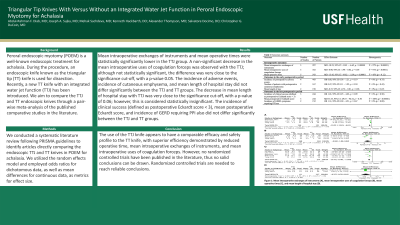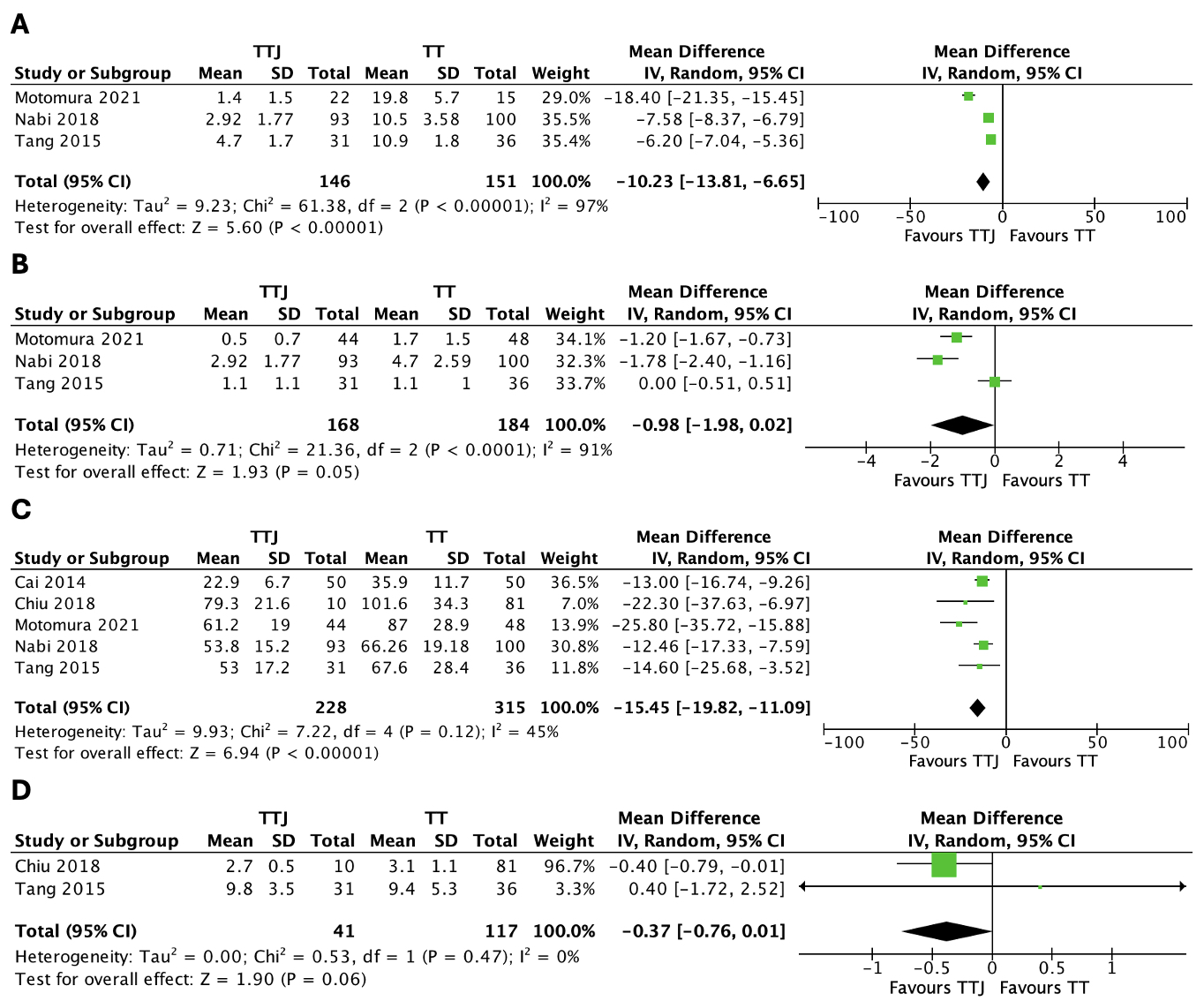Sunday Poster Session
Category: Interventional Endoscopy
P1034 - Triangular Tip Knives With Versus Without an Integrated Water Jet Function in Peroral Endoscopic Myotomy for Achalasia
Sunday, October 27, 2024
3:30 PM - 7:00 PM ET
Location: Exhibit Hall E

Has Audio

Abdul-Rahman F. Diab, MD
University of South Florida Morsani College of Medicine and University of Central Florida, HCA Healthcare GME
Ocala, FL
Presenting Author(s)
Abdul-Rahman F. Diab, MD1, Joseph A. Sujka, MD2, Mehak Sachdeva, MD3, Kenneth Hackbarth, DO3, Alexander Thompson, MD3, Salvatore Docimo, DO2, Christopher G. DuCoin, MD2
1University of South Florida Morsani College of Medicine and University of Central Florida, HCA Healthcare GME, Ocala, FL; 2University of South Florida Morsani College of Medicine, Tampa, FL; 3University of Central Florida, HCA Healthcare GME, Ocala, FL
Introduction: Peroral endoscopic myotomy (POEM) is a well-known endoscopic treatment for achalasia. During the procedure, an endoscopic knife known as the triangular tip (TT) knife is used for dissection. Recently, a new TT knife with an integrated water jet function (TTJ) has been introduced. We aim to compare the TTJ and TT endoscopic knives through a pair-wise meta-analysis of the published comparative studies in the literature.
Methods: We conducted a systematic literature review following PRISMA guidelines to identify articles directly comparing the endoscopic TTJ and TT knives in POEM for achalasia. We utilized the random effects model and employed odds ratios for dichotomous data, as well as mean differences for continuous data, as metrics for effect size.
Results: Mean intraoperative exchanges of instruments and mean operative times were statistically significantly lower in the TTJ group. A non-significant decrease in the mean intraoperative uses of coagulation forceps was observed with the TTJ; although not statistically significant, the difference was very close to the significance cut-off, with a p-value 0.05. The incidence of adverse events, incidence of cutaneous emphysema, and mean length of hospital stay did not differ significantly between the TTJ and TT groups. The decrease in mean length of hospital stay with TTJ was very close to the significance cut-off, with a p-value of 0.06; however, this is considered statistically insignificant. The incidence of clinical success (defined as postoperative Eckardt score < 3), mean postoperative Eckardt score, and incidence of GERD requiring PPI also did not differ significantly between the TTJ and TT groups.
Discussion: The use of the TTJ knife appears to have a comparable efficacy and safety profile to the TT knife, with superior efficiency demonstrated by reduced operative time, mean intraoperative exchanges of instruments, and mean intraoperative uses of coagulation forceps. However, no randomized controlled trials have been published in the literature, thus no solid conclusions can be drawn. Randomized controlled trials are needed to reach reliable conclusions.

Note: The table for this abstract can be viewed in the ePoster Gallery section of the ACG 2024 ePoster Site or in The American Journal of Gastroenterology's abstract supplement issue, both of which will be available starting October 27, 2024.
Disclosures:
Abdul-Rahman F. Diab, MD1, Joseph A. Sujka, MD2, Mehak Sachdeva, MD3, Kenneth Hackbarth, DO3, Alexander Thompson, MD3, Salvatore Docimo, DO2, Christopher G. DuCoin, MD2. P1034 - Triangular Tip Knives With Versus Without an Integrated Water Jet Function in Peroral Endoscopic Myotomy for Achalasia, ACG 2024 Annual Scientific Meeting Abstracts. Philadelphia, PA: American College of Gastroenterology.
1University of South Florida Morsani College of Medicine and University of Central Florida, HCA Healthcare GME, Ocala, FL; 2University of South Florida Morsani College of Medicine, Tampa, FL; 3University of Central Florida, HCA Healthcare GME, Ocala, FL
Introduction: Peroral endoscopic myotomy (POEM) is a well-known endoscopic treatment for achalasia. During the procedure, an endoscopic knife known as the triangular tip (TT) knife is used for dissection. Recently, a new TT knife with an integrated water jet function (TTJ) has been introduced. We aim to compare the TTJ and TT endoscopic knives through a pair-wise meta-analysis of the published comparative studies in the literature.
Methods: We conducted a systematic literature review following PRISMA guidelines to identify articles directly comparing the endoscopic TTJ and TT knives in POEM for achalasia. We utilized the random effects model and employed odds ratios for dichotomous data, as well as mean differences for continuous data, as metrics for effect size.
Results: Mean intraoperative exchanges of instruments and mean operative times were statistically significantly lower in the TTJ group. A non-significant decrease in the mean intraoperative uses of coagulation forceps was observed with the TTJ; although not statistically significant, the difference was very close to the significance cut-off, with a p-value 0.05. The incidence of adverse events, incidence of cutaneous emphysema, and mean length of hospital stay did not differ significantly between the TTJ and TT groups. The decrease in mean length of hospital stay with TTJ was very close to the significance cut-off, with a p-value of 0.06; however, this is considered statistically insignificant. The incidence of clinical success (defined as postoperative Eckardt score < 3), mean postoperative Eckardt score, and incidence of GERD requiring PPI also did not differ significantly between the TTJ and TT groups.
Discussion: The use of the TTJ knife appears to have a comparable efficacy and safety profile to the TT knife, with superior efficiency demonstrated by reduced operative time, mean intraoperative exchanges of instruments, and mean intraoperative uses of coagulation forceps. However, no randomized controlled trials have been published in the literature, thus no solid conclusions can be drawn. Randomized controlled trials are needed to reach reliable conclusions.

Figure: Mean intraoperative exchanges of instruments (A), mean intraoperative uses of coagulation forceps (B), mean operative times (C), and mean length of hospital stay (D).
Note: The table for this abstract can be viewed in the ePoster Gallery section of the ACG 2024 ePoster Site or in The American Journal of Gastroenterology's abstract supplement issue, both of which will be available starting October 27, 2024.
Disclosures:
Abdul-Rahman Diab indicated no relevant financial relationships.
Joseph Sujka indicated no relevant financial relationships.
Mehak Sachdeva indicated no relevant financial relationships.
Kenneth Hackbarth indicated no relevant financial relationships.
Alexander Thompson indicated no relevant financial relationships.
Salvatore Docimo indicated no relevant financial relationships.
Christopher DuCoin indicated no relevant financial relationships.
Abdul-Rahman F. Diab, MD1, Joseph A. Sujka, MD2, Mehak Sachdeva, MD3, Kenneth Hackbarth, DO3, Alexander Thompson, MD3, Salvatore Docimo, DO2, Christopher G. DuCoin, MD2. P1034 - Triangular Tip Knives With Versus Without an Integrated Water Jet Function in Peroral Endoscopic Myotomy for Achalasia, ACG 2024 Annual Scientific Meeting Abstracts. Philadelphia, PA: American College of Gastroenterology.
